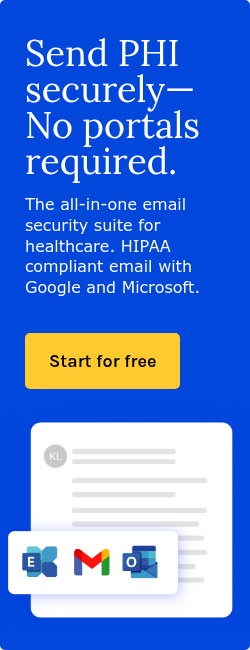
An International Journal of Medical Informatics journal article provides, “Unexpected downtimes related to EHRs appear to be fairly common among institutions in our survey. Most institutions had only partially implemented comprehensive contingency plans to maintain safe and effective healthcare during unexpected EHRs downtimes.”
HIPAA compliant email is a way to ensure that when electronic health records (EHRs) are unavailable, a reliable method of coordinating and sharing patient data is still in effect. This prevents the inevitable additional strain placed on operational activities. It also helps in the promotion of consistent communication that acts as a primary requirement for data integrity.
Understanding data integrity
Data integrity is based on the accuracy, completeness, and consistency of information across its entire lifecycle. A study from The Institution of Engineering and Technology notes, “Data integrity management is a difficult task for health professionals and research scientists. Attackers specifically target healthcare sub-domains to manipulate valuable data. Hence, protecting the integrity of data in medical is the most prioritized issue.”
Healthcare data integrity manifests through precision in patient records, where discrepancies, even minor errors like outdated medications or misrecorded allergies, can cascade into misdiagnoses or inappropriate treatments. For example, incomplete or inconsistent data during telemedicine consultations or EHR updates risks compromising continuity of care, as providers rely on accurate information to administer timely interventions.
The need for contingency planning in healthcare
The healthcare sector is naturally vulnerable to disruptions from workforce shortages and cyberattacks to natural disasters that directly threaten operational continuity. Organizations operate in a high-stakes environment where even brief service interruptions can lead to medication errors, delayed diagnoses, or compromised care quality. EHR system failures during emergencies, for example, risk exposing patients to unsafe care pathways, as clinicians may lack access to medical histories or imaging data. Contingency planning helps navigate these risks by establishing protocols that prioritize resilience and adaptability.
Organizations often enact contingency planning by providing backup staffing pools of per diem or travel clinicians to offset workforce shortages caused by pandemics, strikes, or retirements. These plans also integrate operational redundancies, such as redundant server systems and disaster recovery protocols, to protect data integrity and maintain functions during outages. The planning also has to provide for EHR shutdowns as mentioned in the Contingency Planning SAFER Guide, “Effective contingency planning addresses the causes and consequences of EHR unavailability, and involves processes and preparations that can minimize the frequency and impact of such events, ensuring continuity of care.”
What HIPAA says about contingency planning
When considering the role of HIPAA in contingency planning, it's clear that the regulation places a strong emphasis on preparedness. The Security Rule, specifically under administrative safeguards (45 CFR § 164.308(a)(7)(ii)(A-E)), requires covered entities to develop and implement contingency plans. 45 CFR § 164.308(a)(7)(i) states:
“Establish (and implement as needed) policies and procedures for responding to an emergency or other occurrence (for example, fire, vandalism, system failure, and natural disaster) that damages systems that contain electronic protected health information.”
The plan is necessary for ePHI to remain accessible even during emergencies. HIPAA’s contingency framework addresses risks like data loss, system failures, or natural disasters by requiring organizations to implement proactive protocols for recovery and continuity. Covered entities have to develop disaster recovery plans to restore ePHI access after outages, alongside data backup strategies that create redundant copies of patient records stored on separate media. The legislation does provide some leeway with flexible yet enforceable standards that allow organizations to adapt protocols based on their needs.
Small practices, for example, might rely on cloud-based backups, while larger organizations can afford to have redundant systems and more complex workflows that cost more but provide greater backup security.
The central features of a contingency plan
A HIPAA contingency plan comprises five core components required by the HIPAA Security Rule. These components are structured to address both required and addressable safeguards, enabling healthcare organizations to adapt protocols to their operational needs. The required components include:
- A Data Backup Plan to create and maintain retrievable copies of ePHI. Organizations have to define backup frequency, storage locations, and retrieval processes to guarantee accessibility during outages or cyberattacks.
- A Disaster Recovery Plan focused on restoring ePHI and system functionality after a disaster. It includes protocols for accessing backup data, restoring systems, and resuming operations.
- An Emergency Mode Operation Plan to ensure continuity of functions during emergencies. It specifies procedures for maintaining ePHI security while operating in emergency mode, including employee roles, communication channels, and alternative workflows (e.g., reverting to paper documentation)
The addressable components include:
- Testing and Revision Procedures to test contingency plans regularly and validate their effectiveness. This includes simulated drills, live tests, and post-event reviews to identify gaps (e.g., outdated backup protocols or insufficient training). Revisions are required to address weaknesses and align plans with evolving risks.
- Applications and Data Criticality Analysis which prioritizes systems, applications, and data based on their necessity to operations. Organizations assess which resources are needed for restoring services and allocate recovery efforts accordingly.
When a HIPAA contingency plan comes into effect
An American Psychology Association article notes, “Contingency planning is not just a HIPAA requirement; it is also good business practice. Taking steps to ensure that EPHI can be recovered and restored in the event of an emergency can lessen interruptions to your business. Planning ahead can help you to keep your practice operations running and can help you focus on providing quality services to your clients following an emergency, rather than spending time and energy on efforts — such as tracking down client records — that pull you away from your clinical duties and other practice responsibilities.”
The plan is put into action when a healthcare organization or business associate faces a disruption or emergency that could compromise the security of ePHI. It might happen during natural disasters, system failures, cyberattacks, or any other event that could potentially expose or disrupt access to data.
Part of the contingency plan is establishing a designated person who assesses the situation and decides that activating the contingency plan is necessary to prevent or mitigate damage. Once activated, the plan provides a structured approach to responding to the crisis, including procedures for backing up and recovering data, operating in emergency mode, and restoring systems.
The role of data integrity in contingency planning
Without integrity safeguards, contingency measures risk perpetuating errors or exposing patients to unsafe care pathways. A letter published in Healthcare Technology Letters stipulates, “Various challenges associated with information management in healthcare create many possibilities for attackers to exploit the organization.” A ransomware attack that corrupts EHR data could lead to misdiagnoses if backups lack integrity checks. Incomplete or inconsistent data during emergency workflows, such as hybrid paper-digital documentation during system downtime, could undermine audit trails and accountability. In contingency planning, data integrity manifests as structured protocols that prioritize the accuracy, completeness, and reliability of ePHI.
The benefits of HIPAA compliant email to contingency planning
- Email automatically records details like sender, recipient, date, and time, creating organized records of interactions.
- Secure email services encrypt data during transmission and storage, protecting sensitive patient information.
- Emails can be stored digitally, reducing the need for physical storage space and simplifying record management.
- Secure email platforms facilitate safe communication among healthcare professionals, aiding in coordinated responses during emergencies.
- HIPAA compliant email allows healthcare organizations to quickly share accurate information with patients during disease outbreaks.
The use of HIPAA compliant email to maintain data integrity in contingency planning
While email itself is not secure, HIPAA compliant email platforms like Paubox act as a tool for coordinating responses to emergencies. In these scenarios, email can be used to disseminate information about the status of ePHI, instructions for accessing backup systems, and updates on recovery efforts. It ensures that all parties involved remain informed and aligned.
Within an effective contingency plan, it can also be used to trigger automated workflows or alert systems that initiate backup and recovery processes, thereby ensuring that data remains intact even if primary systems are compromised. The approach supports compliance with HIPAA's contingency planning standards and improves operational resilience.
The use of HIPAA compliant email in a contingency plan
- PHI recovery: Restore encrypted emails to resume care workflows post-disruption.
- Emergency communication: Securely share PHI with authorized parties (e.g., providers, labs) during outages.
- Audit trails: Maintain logs of email activity to track PHI access and breaches.
- Patient consent: Use email to notify patients of risks if unencrypted channels are used during emergencies.
FAQs
What types of emergencies must a HIPAA contingency plan address?
A HIPAA contingency plan must address various types of emergencies, including natural disasters, fires, vandalism, system failures, cyberattacks, and ransomware incidents.
How often should a HIPAA contingency plan be tested and updated?
While testing and revision procedures are considered addressable, it is recommended that contingency plans be tested and updated regularly, ideally at least annually, to ensure effectiveness and compliance.
What is the purpose of an emergency mode operation plan in a HIPAA contingency plan?
The purpose is to enable the continuation of business processes for protecting the security of ePHI during and immediately after a crisis.
How should data backups be managed under a HIPAA contingency plan?
Data backups should be created regularly, stored securely offsite, and tested to ensure that ePHI can be restored effectively. A 3-2-1 backup strategy is recommended: three copies of data, stored on at least two different media, with one copy stored securely offsite.
Can a HIPAA contingency plan be borrowed from another organization?
No, a contingency plan should be tailored specifically to the organization's needs, policies, and structure.
Subscribe to Paubox Weekly
Every Friday we'll bring you the most important news from Paubox. Our aim is to make you smarter, faster.




